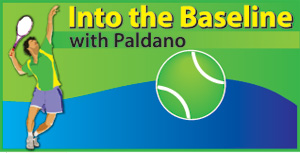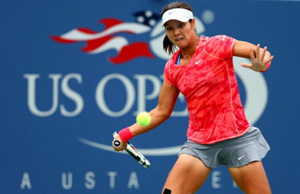‘Anatomy’ of the US-Open
View(s):The city that hosts USA’s national Tennis championships, the US-Open is the ‘big apple’ New York. For a long time, this last Grand Slam of the year has been the final show down in the Tennis calendar. Even today, although there are some other events after the US-Open, it is seen as the end of the year’s Tennis season. The last of the newly formed US-Open-series which is a prelude to the US-Open, is now on. For two weeks from 31st September, it will be US-Open time and for those waiting eagerly to watch the matches on TV or to see them live in New York, there is sure to be some major surprises.
 The US-Series events which are also played on hard-courts will be, in a way, an indicator of the players’ performance at the US-Open. The series has indeed achieved its purpose to kindle more Tennis interest worldwide towards the US-Open. As a spectacle and as a sporting event, the US-Open has an Olympic ‘aura’. It is an incredible achievement by the city of New York to take a single sport and conduct an event for only for two weeks and make it phenomenally interesting globally.
The US-Series events which are also played on hard-courts will be, in a way, an indicator of the players’ performance at the US-Open. The series has indeed achieved its purpose to kindle more Tennis interest worldwide towards the US-Open. As a spectacle and as a sporting event, the US-Open has an Olympic ‘aura’. It is an incredible achievement by the city of New York to take a single sport and conduct an event for only for two weeks and make it phenomenally interesting globally.
It does not stop there. As a Grand-Slam event it has stemmed the global Tennis in lean periods of the game with the infusion of energy, enthusiasm and entertainment, every time. A challenge many of the National associations and cities do not seem to be able to withstand.
The attraction that the US-Open presents does not only draw tennis enthusiasts to visit the city but brings in thousands of visitors from all over the world. Visitors come to Flushing Meadows to see the Billie Jean King centre and the Arthur Ash stadiums round the year. It is recorded that during the US-Open event last year, 713,026 fans attended the event. It probably beats all grand stand attendance counts of any sport by many folds.
Anatomy of the US-Open
The singles draw is 128 entries for each gender and to be eligible the players must be in the first 200 of the world ranking. Elite players work round the year and squeeze themselves into the elite ‘cut-off’ mark of 160th position of the ranking. The players outside the automatic entry mark will have to play qualifying rounds to come into the main draw in all the events. In last year’s draw, players from 41 countries managed to do that and appeared in the first round of the draw in the men’s open singles. Inclusive of doubles and mixed doubles, the draw could be represented by around 50 nations.
 The other matter of concern in the event is the seeding process to position good players in the draw. It places first 32 recognised players in predetermined positions. This is not an arbitrary system but that which evolved over a century. The purpose of it is to distance good players from playing each other in the early rounds of the event.
The other matter of concern in the event is the seeding process to position good players in the draw. It places first 32 recognised players in predetermined positions. This is not an arbitrary system but that which evolved over a century. The purpose of it is to distance good players from playing each other in the early rounds of the event.
In this manner, higher ranked players will only meet in the final rounds of the event making it interesting to the spectators, provided the elites survive the challenge till then. By now, the 2015 seeded players list must have been announced for the event and could be seen in the US-Open website. There will be 32 seeds in singles in each gender.
The playing format at the US-Open is best of five sets for men and three for women. Except for the final set, all others will go into tie-breaks at six games all. Some of these matches can go over 4 hours in duration. In total, there will be the big five open events – the women’s and men’s singles, two doubles and the mixed doubles. Apart from these, there will be age group events for juniors, seniors and invitation events of prominent past players.
These have a different format. The two week event will have around 600 matches and a total of around 500 players will participate. Since the professional bodies came to being, there is prize money from the very first round and the event organizers do not take the responsibility for players’ hospitality and travel. This was the case when the Tennis events were for amateurs only.
Money and its big money
Money is the scale which measures sports events today. Professional tennis events are categorized by the strength of the prize money by the two professional bodies. The total prize money in the US-Open this year is around US$ 40 million inclusive of the US-Open-series performance prizes. Two Singles winners will take home 3.3 million each and runners up 1.6 million each. Doubles winners will take 560,000 US dollars each.
The gross income to New York through US-Open inclusive of the external multipliers is probably around one and half billion dollars. The national association of USA gets close to 200 million dollars from the event to promote the game in the country. If an event is successful, everyone from the spectators, organizers, media and the players, are all winners!
Media interest
The New York event could be witnessed from any point in the globe round the clock on TV. The media digs into the large spectrum of the event and has something for everyone to follow US-Open.
Social, print and electronic stays alive intensely during the event. They use the material as the springboard to sustain Tennis interest round the year with interesting TV clips, replays in dedicated channels and pages. Media also is acts as a watch dog system for controls in all fronts. It is even said that sports coverage by the media was the model for today’s political and global coverage of social events. They do have the power to make Tennis idols famous and also at times infamous.Nations and relative Tennis standard
About 50 countries have their name registered in the Grand-Slam Tennis events through their players. If the nation is outside Europe and the Americas, it is a tough task to achieve this feat. Few good players from Asia and Africa appear in the open singles draw only by placing themselves either in Europe and the US. The world professional bodies WTA and ATP have extended the Tennis interest to October for men and November for women with their year-end events. It would be Singapore for women and London for men. They are closed events by invitation or better said by achievement to the top eight players in the world ranking.
In smaller nations with their narrow spectrum of player base, results of events are predictable as to who will win in the next few years or narrow it down to three players. The draw exhibits a very narrow spectrum and playing standard. Being unattractive, these nations and their events are not in a position to attract overseas players.
The most critical aspect of this is the downfall of the nations own tennis popularity and Tennis standard. Some formula must be found by these nations to revert this trend. Events are not about billboards, cut-outs and sponsorship but it is about creating good situations for good players to play good Tennis. If there is good Tennis, good events will come to being. This is the secret behind the success story of the US-Open.
George Paldano, former international player; Accredited Coach of Germany, National coach, Davis Cup and Federation Cup Coach; ITF and USPTR; –gptennis.
ceylon@gmail.com


